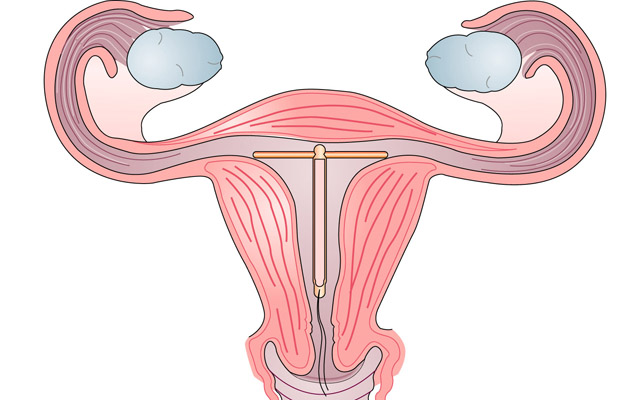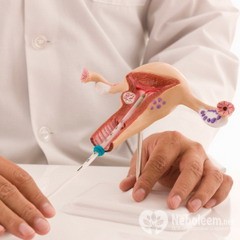In this article:
It is believed that female body It takes about a year to recover from childbirth. During this period, doctors do not recommend planning a new pregnancy. In this connection, a young mother faces a difficult task - to choose an effective and safe method of contraception.
One of the most effective ways preventing unwanted pregnancy is the installation of an intrauterine device. But is it harmless to the baby if the mother is breastfeeding? Which spiral after childbirth is better to put? When can it be done? You will find answers to these and other questions in our article.
The principle of operation and types of spirals
Intrauterine device(IUD) is a small, flexible device that is inserted into the uterine cavity to prevent pregnancy. The most commonly used spirals in the form of the letter "T", but there are also ring-shaped devices.
The principle of operation of the IUD is determined by its type:
- non-drug spirals made of plastic with the addition of metal simply prevent the fertilized egg from attaching to the uterine mucosa (today they are practically not used);
- medications, that is, containing copper ions or the hormone progestin, in addition to creating a physical barrier, also affect sperm motility, ovulation, endometrial structure and the density of church mucus.
Regardless of the type this remedy contraception has absolutely no effect on lactation. Therefore, if a nursing mother decides to put a spiral after childbirth, then it is absolutely safe for the baby.
Features of the installation of the Navy
Insertion and removal of the IUD can only be performed by a qualified gynecologist in a hospital setting. The procedure should be preceded by an examination of a woman: examination, ultrasound of the pelvis, testing for infections of the genitourinary system.
An IUD can be inserted six to eight weeks after natural childbirth, provided that they were simple, and the woman had no contraindications. If the birth was by caesarean section, then the procedure must be postponed for six months. In any case, when and how to put a spiral after childbirth, the doctor determines.
As a rule, the spiral after childbirth is introduced during menstruation, this approach is considered the least traumatic. But if a woman is breastfeeding, and her cycle has not yet recovered, then the procedure can be performed at any time. The installation of the spiral occurs quickly and is practically not accompanied by painful sensations.
The validity period of the IUD is from three to eight years, depending on the model, but at the request of the woman, it can be removed at any time.
How to behave after the procedure?
In the first week after the insertion of the IUD, it is forbidden to have sex, use tampons, douche, go to the sauna and expose the body to heavy physical exertion.
In the future, the spiral does not affect the woman's life in any way. You can lead an active lifestyle, go to the pool, breastfeed the baby, carry it in your arms, and so on. A correctly installed IUD is also not felt during sexual intercourse. However, after menstruation, it is worth checking the reliability of fixing the device - feel for the threads that are located in the vagina. This is especially important if a woman uses tampons.
Another significant point is a timely visit to the gynecologist. After the insertion of the IUD, it is necessary to pay a visit to the doctor twice: after ten days and after six weeks. In the future, even in the absence of complaints, it is recommended to undergo an examination once every six months.
You need to see a doctor urgently if:
- there was a delay in menstruation, accompanied by signs of pregnancy;
- felt severe pain in the lower abdomen, especially against the background of fever;
- the threads of the IUD in the vagina are not groped.
Advantages and disadvantages
How to decide for yourself the question of whether to put a spiral after childbirth? Feedback from other women and medical advice will help with this. It is also worth analyzing the advantages and disadvantages of this method of contraception.
Positive characteristics of the Navy:
- valid immediately after installation for up to eight years;
- the effectiveness of preventing pregnancy - 99%;
- does not affect lifestyle, sexual intercourse and lactation;
- after the removal of the spiral, the ability to conceive is quickly restored;
- when using the IUD with progestin, the pain and duration of menstruation, as well as the amount of discharge, decrease;
- relative cheapness.

Negative characteristics of the Navy:
- during the first two weeks after the procedure, a woman may be disturbed by discomfort in the pelvic area, and sometimes discharge with blood also appears;
- in the first three months, an increase in the duration of menstruation and the volume of discharge, as well as increased pain, is possible;
- the spiral not only does not protect against sexual infections, but also increases their likelihood, so it is not like women who do not have a permanent sexual partner;
- sudden changes in mood, the appearance of rashes on the skin, a decrease or increase in sexual desire are possible.
Most of the above disadvantages are inherent only in copper-containing spirals. Models with progestin rarely cause side effects, although everything is determined by the characteristics of the woman's body.
Contraindications and side effects
For all its merits, the intrauterine device after childbirth can not always be used. The main contraindications include:
- diseases of the genital organs (oncological, inflammatory, venereal, and so on);
- pathology of the development of the uterus;
- uterine bleeding;
- breast cancer, heart disease, hepatitis - for IUD with progestin;
- pregnancy.
Possible side effects:
- pain, spotting;
- heavy menstruation;
- infectious and inflammatory pathologies of the genital organs;
- infertility (extremely rare);
- the onset of an ectopic pregnancy;
- spiral drop.
The spiral during lactation is an effective means of contraception. The main condition for the effectiveness and safety of this method is an appeal to a highly qualified gynecologist and an attentive attitude to your body.
Doctor's story about intrauterine contraception
The intrauterine device is a T-shaped contraceptive, which is a device made of copper (silver, gold) and plastic that prevents sperm from entering the uterine cavity. If the fusion of the sperm with the egg has already occurred, the spiral does not allow the fertilized egg to attach to the surface of the uterus, resulting in its abortion in the second half of the menstrual cycle.
The prototype of the first intrauterine device was a ring made of an alloy of bronze and brass with a small content of copper, proposed as a contraceptive German doctor Ernst Grafenberg in 1926. A few decades later, in 1960, the American gynecologist Jack Lipps developed a device called the Lipps loop. In its manufacture, an elastic material was used, which eliminated the risks of tissue trauma during the installation of the IUD.
Many women of childbearing age ask the question: “Is it possible to put a spiral? Will the presence of a foreign body harm the body? Let's try to figure this out.
General information about the Navy
The installation of the spiral is carried out only in medical institution after passing the tests and examining the patient by a gynecologist and is recommended for women who have given birth without any identified infectious inflammatory diseases urinary area.
The device is placed for a period of 3-5 years on the third or fourth day from the onset of menstruation, which theoretically excludes the woman from pregnancy. Sexual life is allowed to be conducted on the 8-10th day after its introduction.
To avoid risks possible complications Before the introduction of the IUD, the doctor prescribes the following tests to the woman:
- Bacteriological analysis of smears of the cervix and vagina;
- General analysis of urine and blood;
- Testing for sexually transmitted infections (hepatitis B and C, syphilis, HIV);
- Ultrasound of the pelvic organs.
Installation of a spiral is possible only if there are I and II degrees of purity of the vaginal sphere. If an infectious-inflammatory disease is detected, the gynecologist prescribes an in-depth study and conducts antimicrobial treatment. Before the introduction of a contraceptive, a 6-month break is necessary for complete recovery in order to exclude the transition of the disease into a chronic form.
The question “is it possible to put a spiral” can only be answered by a specialist at an individual consultation. Women with a history of childbirth and multiple abortions should be cautious about the insertion of the coil, as in some cases (in 1%), the IUD can cause perforation (perforation) of the walls of the uterus.
many women  Interested in whether it is possible to put a spiral after childbirth to reduce the risk of re-pregnancy? Experts answer unequivocally: "it is possible". The introduction of the IUD can be carried out 2-3 months after childbirth after examination by a gynecologist. If a woman plans to become pregnant, fertilization is possible already in the first month after the removal of the spiral by a specialist.
Interested in whether it is possible to put a spiral after childbirth to reduce the risk of re-pregnancy? Experts answer unequivocally: "it is possible". The introduction of the IUD can be carried out 2-3 months after childbirth after examination by a gynecologist. If a woman plans to become pregnant, fertilization is possible already in the first month after the removal of the spiral by a specialist.
The opinion of gynecologists on this issue differs: some are sure that it is impossible, other experts say that it is possible, but only when all the necessary studies are carried out. But the points of view of doctors agree on one thing: even the most professional installation of the spiral can cause undesirable complications for women's health.
Adverse reactions associated with IUD implantation are most often observed in patients with chronic pelvic inflammatory disease, irregular menstruation, as well as in nulliparous women, which allows you to partially answer the question "is it possible to put a spiral in nulliparous women."
At the time of the introduction of an intrauterine contraceptive, uterine bleeding may occur, less often - damage to the cervix. In the process of contraception, a certain percentage of women complain about:
- Drawing pains in the lower abdomen;
- Menometrorrhagia (bloody discharge), which is against the background of heavy bleeding upon receipt drug treatment is an indication for the removal of the spiral;
- Inflammatory diseases of the pelvic organs. Inflammatory reactions with IUDs occur in about 4-15% of cases and can manifest as endometritis, cervicitis, pelvioperitonitis, and pelvic abscess. In the transition to a chronic form, these diseases can provoke a violation of the reproductive function and lead to infertility, which can be a severe psychological trauma for a nulliparous woman.
The installation of an intrauterine device, as mentioned above, increases the risk of inflammatory diseases of the pelvic organs (due to the fact that the cervix is always slightly open), the onset of an ectopic pregnancy and thins the endometrial layer in the uterus, which can negatively affect the development of a desired pregnancy, increasing the risk of miscarriage.
So, is it possible to put a spiral on nulliparous women? In fact, it is possible, and this practice is widespread in the work of gynecologists. However, girls who are just about to become mothers in the future are advised to use alternative means of protection: condoms, oral contraceptives, suppositories, etc.
Contraindications to the installation of the IUD
On forums on the Internet, you can find out that at a gynecologist's appointment, many women are interested in whether it is possible to put a spiral in the presence of diseases of the genital area. Experts voiced a list of direct contraindications to the introduction of an intrauterine device. These include:
- Bloody discharge of unknown etiology;
- Inflammatory and infectious diseases of the small pelvis;
- Fibromyoma, deforming the uterus;
- Pathology of the cervix (erosion, polyps, cervicitis);
- Malignant tumors of the cervix and body of the uterus;
- Pregnancy.
Relative contraindications to the installation of the IUD include an ectopic pregnancy in the past, diseases associated with bleeding disorders, heart defects, and painful menstruation. Also, the use of an intrauterine device is not recommended for women who have experience with many sexual partners.
Thus, it is possible to use the spiral as a means of protection, but only taking into account possible risks, weighing all the pros and cons.
With the advent of a baby in the house, the life of newly-made parents changes dramatically. Feeding, changing diapers, teething, vaccinations and other delights of caring for a baby make it impossible to get enough sleep. What can we say about the return to intimate life with her husband. Today we will discuss when a spiral can be placed after childbirth.
Let's weigh all the pros and cons
Immediately after delivery, no mother returns to intimate life. This is contraindicated by the doctor, and physiological recovery takes a lot of time. A few weeks go by and couples welcome intimacy back into their lives. It is during this period that unexpected fertilization can occur. Contraceptives will help prevent unwanted pregnancy after delivery.
Women need to take care of contraceptives. Of course, many couples use condoms, the calendar method, or withdrawal. Is there some more oral contraceptives, but they are not allowed for everyone, especially after childbirth. The leading position among new mothers is occupied by the intrauterine device.
Read also:
When can an intrauterine device be inserted after childbirth? Only an obstetrician-gynecologist can answer this question for you. As medical practice shows, spirals can be inserted into the uterine cavity within 48 hours after delivery. Later, this procedure has its own nuances. We will return to this a little later, but now let's find out what are the advantages of the described contraceptive.
The intrauterine device, regardless of the type and shape, has a number of advantages:
- in the next five years, a woman may not worry about an unplanned pregnancy;
- the spiral is not felt at all, even during sexual contact;
- the presence of a spiral inside the uterine cavity does not affect hormonal background and lactation;
- spiral efficiency tends to 100%;
- procedure availability.
Women who have already tried this method of protection on themselves also express their dissatisfaction, in particular:
- in the presence of a spiral, the abundance of menstrual bleeding increases;
- intensify pain during menstruation;
- the intrauterine device does not protect against infectious pathologies;
- with the wrong choice or installation of the spiral, an inflammatory process may develop.
About the intrauterine device in detail

To date, two types of spirals are used in medical practice:
- non-drug;
- medical.
The first type of contraceptives is made of plastic with an admixture of metal, but it has already outlived its usefulness and is rarely used. But medical intrauterine devices are used everywhere. They are made of copper wire with the addition of the hormone progestin.
How soon after childbirth can I put a spiral? This question interests many women who are not ready to raise children of the same age. If the delivery went without complications and naturally, then you can insert a spiral into the uterine cavity within 48 hours after childbirth.
If you did not immediately enter the spiral, then you can do this after 6-8 weeks after delivery in a natural way. But first you need to undergo an examination and consult a doctor. Gynecologists say that it is impossible to get pregnant during lactation, because breast-feeding and ovulation are mutually exclusive concepts. However, there are exceptions to any rule, so the issue of contraception should be given special attention.
Is it possible to put a spiral immediately after childbirth if a caesarean section was performed? No. Any obstetrician-gynecologist will give you such an answer. If the delivery was carried out by surgical intervention, then the decision on the introduction of the spiral should be postponed for the next six months.
In the maternity hospital, not every woman thinks about contraception. Just a couple of days ago, she became a mother, her life has changed, so many troubles have piled up. And only after discharge from the maternity hospital and returning to normal life, the issue of contraception becomes acute.
After natural childbirth, the spiral can be installed after 6-8 weeks. It is best to do this during menstrual bleeding. If the first menstruation after the birth of the crumbs has not yet passed, then a woman can install a spiral on any day.
A few words about gynecological manipulation
The procedure for introducing an intrauterine device is preceded by a comprehensive examination. A woman needs to pass a series of tests, including blood and urine, to make ultrasound procedure pelvic organs, as well as undergo a visual examination through gynecological mirrors.
The procedure is practically painless, although heaviness in the lower abdomen and pulling pains may be felt. They pass in a few hours. If pain and discomfort accompany a woman all the time, this is an alarming signal and an urgent need to visit a doctor.
During the first week after the introduction of the intrauterine device, a woman expects a number of restrictions:

- you can not have sex;
- the body should not be subjected to exhausting physical exertion;
- you can not lift weights;
- douching procedures are prohibited;
- it is not recommended to visit the bath or sauna;
- you can't swim in the pool.
In the future, you can return to your usual life without restrictions. After the procedure for introducing a spiral into the uterine cavity, the doctor should be visited on the 10th day. Plan a follow-up visit for 6 weeks.
Depending on the type of spiral, its shelf life varies from 3 to 8 years. At any time, a woman can get rid of an intrauterine contraceptive. To protect yourself, visits to the gynecologist should be periodic: at least once every six months.
Are there any contraindications?
Today the pharmaceutical market is crowded various types spirals. Each of them has its contraindications, but there are common points. So, the spiral cannot be installed in such cases:
- in the presence of malignant or benign neoplasms;
- with pathology of the uterine cavity and its neck;
- with the development of inflammatory or infectious processes.
In each individual case, the doctor selects a suitable intrauterine device. A woman may be advised to use an alternative method of contraception if she is allergic to copper or has a chronic condition.
The presence of a spiral in the uterine cavity can cause the development of side effects:
- bleeding;
- heavy menstruation;
- inflammation;
- spasms;
- infectious diseases.
A child was born and a young woman, in addition to caring for him, should think about preventing the onset new pregnancy. Breastfeeding women should be especially careful. During the lactation period, suitable means of protection against the onset of pregnancy are special hormonal preparations, barrier methods (for example, a condom), which are not considered convenient for long-term use, as well as a postpartum coil (IUD). Many women ask themselves questions: should I put a spiral after childbirth and how is the IUD considered a reliable means of preventing unwanted pregnancy? Let's try to figure them out.
Why should I put a spiral after childbirth?
- The effectiveness of protection against the onset of pregnancy is more than 90%;
- the intrauterine device after childbirth is installed for a period of 2 to 8 years;
- minimal side effects in the form of pain and strong bleeding during menstruation or their absence at all;
- the absence of any inconvenience during intercourse;
- quick installation and affordable price;
- no effect on milk secretion;
- the absence of any negative effect on the child's body.
What is a contraindication to the installation of the IUD?
- Inflammatory diseases.
- Pathological structure of the uterus.
- Benign and malignant tumors reproductive organs and especially the uterus.
- Frequent change of sexual partners, as the risk of infection transmission increases.
- IUDs should not be placed in women who experience profuse metrorrhagia (uterine bleeding).
- With complications in the early and late postpartum period.
When is the spiral placed after childbirth?
The ideal time for inserting an IUD is as soon as the postpartum discharge stops, on the days of the first menstruation, since that is when the manipulation is carried out with the least damage to the cervix. But due to the fact that many women do not have menstruation during lactation, the IUD can be inserted within the next 48 hours after the birth of a child while still in the maternity hospital. The intrauterine device after caesarean section is established only after a few months, when the pelvic organs are completely restored. Then, once every six months, a woman needs to visit a gynecologist in order to control the position of the IUD in the uterine cavity.
Which spiral is better after childbirth?
Only a gynecologist has the right to determine which spiral to put after childbirth. There are the following types of IUDs:
- IUDs made of plastic and metal. The mechanism of action is very simple: they do not allow the fertilized egg to attach to the uterine mucosa. Currently used extremely rarely;
- Medical IUDs contain either hormonal drug or copper ions. These IUDs affect various physiological processes: the density of the mucus of the cervical canal of the cervix, ovulation, the mobility of male germ cells, etc.
How is the IUD inserted in the postpartum period?
 Before putting the spiral after childbirth, watch the video and photo, this will help you understand how it is installed and how it is located in the uterine cavity. The installation of the IUD is carried out only within the walls of the hospital by a gynecologist, after a preliminary examination of the pelvic organs and taking swabs. Manipulation is carried out on a gynecological chair. Very often, ultrasound is required to confirm the correct position of the IUD. As a rule, during the procedure, a woman may feel some discomfort. It should be remembered that the IUD does not protect against diseases that are sexually transmitted.
Before putting the spiral after childbirth, watch the video and photo, this will help you understand how it is installed and how it is located in the uterine cavity. The installation of the IUD is carried out only within the walls of the hospital by a gynecologist, after a preliminary examination of the pelvic organs and taking swabs. Manipulation is carried out on a gynecological chair. Very often, ultrasound is required to confirm the correct position of the IUD. As a rule, during the procedure, a woman may feel some discomfort. It should be remembered that the IUD does not protect against diseases that are sexually transmitted.
Contraceptive pills Femulen
Femulen - oral monohormonal contraceptive drug containing a synthetic analogue of natural progesterone - ethinodiol. The drug belongs to...
